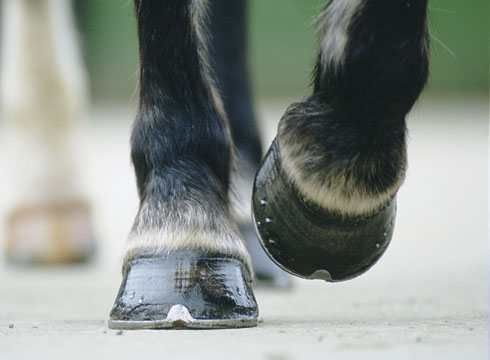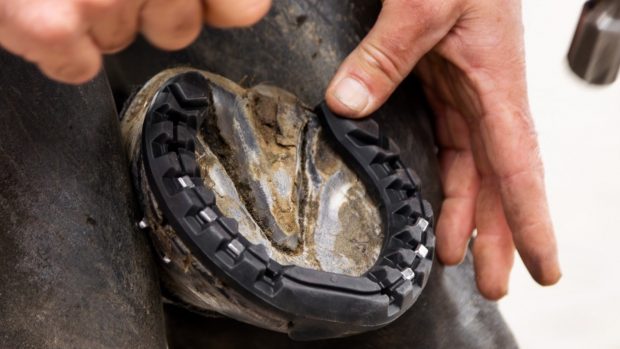Wet, muddy ground is one of the worst aspects of caring for horses during winter. If it’s not dealing with filthy rugs and muddy legs, then it’s the inevitable situation when your horse loses a shoe after spending time in a paddock that looks more like a battleground than turnout space.
Lost horseshoes aren’t just an expensive nuisance, either. Horses can tear off part of their hoof at the same time the shoe is being pulled off, and then there’s the time spent finding that lost shoe, which can be a serious hazard if not retrieved.
What can be done to prevent a horse losing a shoe?
Overreach boots
A correctly-fitted pair of the best overreach boots are a must, according to farrier Paul Raw. “It’s not just about keeping the shoe on — they also protect your horse from overreach injuries. I find the long rubber boots are best; make sure they are big enough to drop down fully over the heel when the foot is in flight,” he advises.
Regular shoeing
Another must is regular shoeing on a schedule which takes account of both what the horse is doing and at what activity level. “Most people assume horses should go six weeks between shoeings — but if you’re an endurance rider doing miles of training, it is common sense shoes will need renewing more often. Make sure, too, that you tell your farrier what you are doing with your horse, as the way the foot is dressed and the type of shoe used will alter accordingly,” says Paul.
Consider the barefoot option
How about considering going barefoot over the winter (or even permanently)? If your horse is having some down time after a busy season, it’s easier on the pocket and your paddock, as well as better for his feet, to have a period without shoes. And no shoes on means no shoes to come off – apart from hoof boots, of course, but these are easier to pop back on.
Talk to your farrier
If you have a repeat offender for lost shoes, discuss the problem with your farrier to review possible causes and how to address them. “Wire fencing is a common culprit, for example,” says farrier Phillip Denton. “Horses paw at the fence then catch the shoe on the wire and tear it off.”
Look after your horse’s feet
Sounds obvious, but Phillip says not everyone takes the time to pick out feet daily or apply a good quality hoof dressing to protect the hoof wall and soles. “There’s a big difference in terms of hoof quality between horses which aren’t receiving that attention to detail and those which are; you can’t fool your farrier! It’s our job to put the shoes on correctly, but it’s the owner’s job to help them stay on — and healthy hooves are more likely to keep their shoes.”
Consider your horse’s diet
And finally, make sure your horse’s diet is designed for optimal hoof health. Equine nutritionist Clare MacLeod MSc RNutr says hooves rely on an adequate supply of essential nutrients for strength, resilience and health, and good growth rate. “It’s a misunderstanding of nutrition to simply add a hoof supplement into the diet before investigating whether the basic diet is balanced,” she says. “A balanced diet is absolutely essential for all body parts to function correctly, yet many horses’ diets are not balanced.”
“UK forage is typically short of minerals and preserved forages such as hay and haylage can be short of vitamins. Diets with high levels of grass or starchy concentrate may oversupply water soluble carbohydrates, which can detrimentally affect the hooves.
“The most common error is to feed less than the full recommended amount of a compound feed, then top it up with a balancer or vitamin and mineral supplement, when feeding a horse whose energy requirements aren’t enough for the regular amount of hard feed,” says Clare.
She adds that once the diet is balanced, some horses do respond in terms of hoof health to higher than optimal levels of certain nutrients, including the sulphur-containing amino acid methionine, the essential micro-mineral zinc and the B-complex vitamin biotin.
“Other nutrients that might be found in hoof supplements include copper, MSM, calcium and magnesium. Investigate daily servings to ensure adequate levels and feed for an extended period of many months before expecting results.”
You might also be interested in:
A good working relationship with your farrier will make any horse owner's life easier, so what does a farrier recommend

No foot, no horse – hoof supplements to help maintain healthy hooves

Put your best foot forward – and make it shine with one of these great hoof oils

12 pairs of overreach boots that will help to protect your horse

How to keep your farrier happy

Struggling with mud fever? Here’s what you need to know to tackle it…

Subscribe to Horse & Hound this spring for great savings
Horse & Hound magazine, out every Thursday, is packed with all the latest news and reports, as well as interviews, specials, nostalgia, vet and training advice. Find how you can enjoy the magazine delivered to your door every week, plus options to upgrade your subscription to access our online service that brings you breaking news and reports as well as other benefits.





